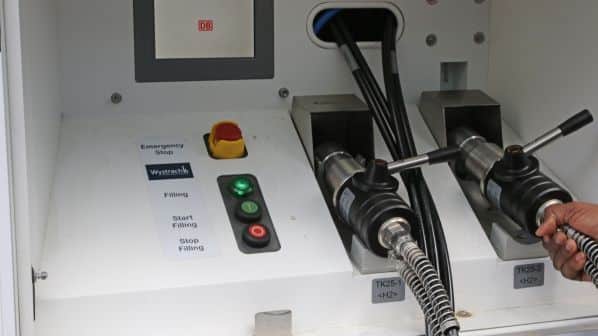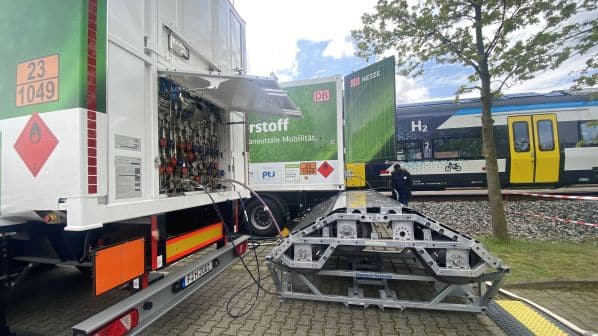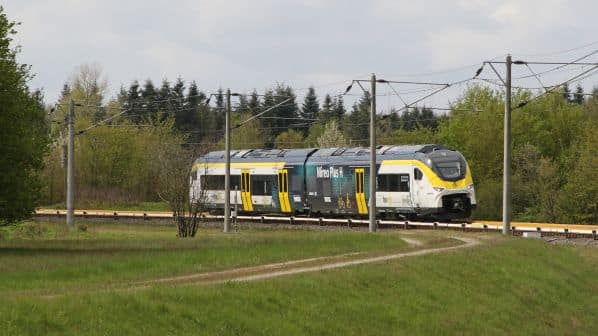H2goesRail hydrogen refuelling station to include catenary powered …
The system will be trialled in Tubingen later this year. The storage system on the left stores 900kg of hydrogen at up to 300 bar, while the system on the right pressurises it to 500 bar ready for refuelling.
THE mobile hydrogen refuelling station developed by Siemens and German Rail (DB) under the H2goesRail project[1] is due to be moved to Tubingen, Baden-Wurttemberg, in September, where it will be connected with an electrolyser powered through the catenary system to produce fully green hydrogen. DB presented the existing system to journalists at Siemens Mobility's Test and Validation Centre in Wildenrath, North Rhine-Westphalia, on April 26.
The Mireo Plus H hydrogen train and Mireo Plus B battery train were also demonstrated in operation. "We at DB are striving to be climate-neutral by 2040," says DB H2goesRail project manager, Mr Marc-Andre Sahba. "Our target is to provide our passengers with real climate-neutral mobility and our mission is to introduce a complete system consisting of a hydrogen train from Siemens together with our hydrogen supply solution.
 The refuelling system includes two nozzles, one for each tank onboard the train.
The refuelling system includes two nozzles, one for each tank onboard the train.
"In order to make that happen we need to think where the hydrogen will be produced, where it will be stored and where the train will be refuelled. Our answer is at the same place: we're going to produce the hydrogen where [the train] is going to be refuelled."
The system installed at Wildenrath consists of two 20ft containers mounted on road trailers. Making the system mobile is important, explains DB Energy project manager, Mr Lennart Fink, as it is eventually due to undergo trials at several multiple sites across Germany. The first container can store 900kg of hydrogen at a pressure of 300 bar, with this currently taken off-site to be refuelled weekly with grey hydrogen.
Grey hydrogen is produced from fossil fuels, while green hydrogen is completely renewable. Fink explains that a normal hydrogen storage tank can only be drained to 55%, so the storage system is split into 10 sections, allowing each section to be individually pressurised to enable 85% of the hydrogen to be used.

The storage container is connected to the refuelling container via three small hoses, including two for hydrogen and one for compressed air. The individual cylinders storing the hydrogen are made with a polycarbonate shell coated with a carbon fibre foil, and are able to withstand pressure of up to 500 bar.
However, they must remain pressurised while being emptied to prevent them from collapsing, so the system pumps pressurised air back into the storage units during refuelling. The refuelling system takes the 300 bar hydrogen from the storage unit and further compresses it to 500 bar. The system also has a cooling unit which cools the hydrogen to -5oC.
The Mireo Plus H is a two-car multiple-unit, with each car equipped with its own fuel cell and hydrogen storage tanks that work independently of each other. Fent says this allows the train to continue operating even if one fuel cell fails. Each storage tank, which can hold 90kg of hydrogen, is filled simultaneously and Fent says the aim is to refuel the train with 180kg of hydrogen in 15 to 20 minutes.
 The Mireo Plus H hydrogen train was presented in operation for the first time on April 26,
The Mireo Plus H hydrogen train was presented in operation for the first time on April 26,
The system is equipped with wireless communication between the train and the refuelling system, to allow the refuelling system to identify the pressure and temperature of the hydrogen already onboard the train.
"The refuelling station and the train need to communicate about the pressure and the temperature of the train when it arrives at the station," Fink says. "You need a certain temperature and a certain pressure. If the train is arriving, for example, with 20 bar [remaining in the tanks], we might start with 50 bar, and then we go higher and, in the end, use our 500 bar in storage to reach 350 bar on the train." The full system is due to be moved to Tubingen in September, where nine additional modules will be added by the end of this year.
This will include an on-site electrolyser that will be powered by the overhead catenary system to draw power from DB's existing electrification network to produce green hydrogen. "Our idea was to use the catenary because we have quite a strong electrification system which is independent from the public grid, and that can supply bigger electrolysers," Fink says. "Otherwise you have the problem that you need the local network to supply your electrolysers or for a battery train, you needed it to supply an energy Island, and that can be very difficult because we might need more electricity than a whole village consumes." DB Energy has developed a coupler system to connect with the catenary, and this system could also be used in future to supply renewable energy direct from a wind or solar plant into the network.
The coupler is able to convert the 15kV 16.7Hz used on the German rail network to 400V 50Hz to power the electrolyser.
The Mireo Plus H is due to begin test runs on the Tubingen - Pforzheim line later this year.
References
- ^ developed by Siemens and German Rail (DB) under the H2goesRail project (www.railjournal.com)